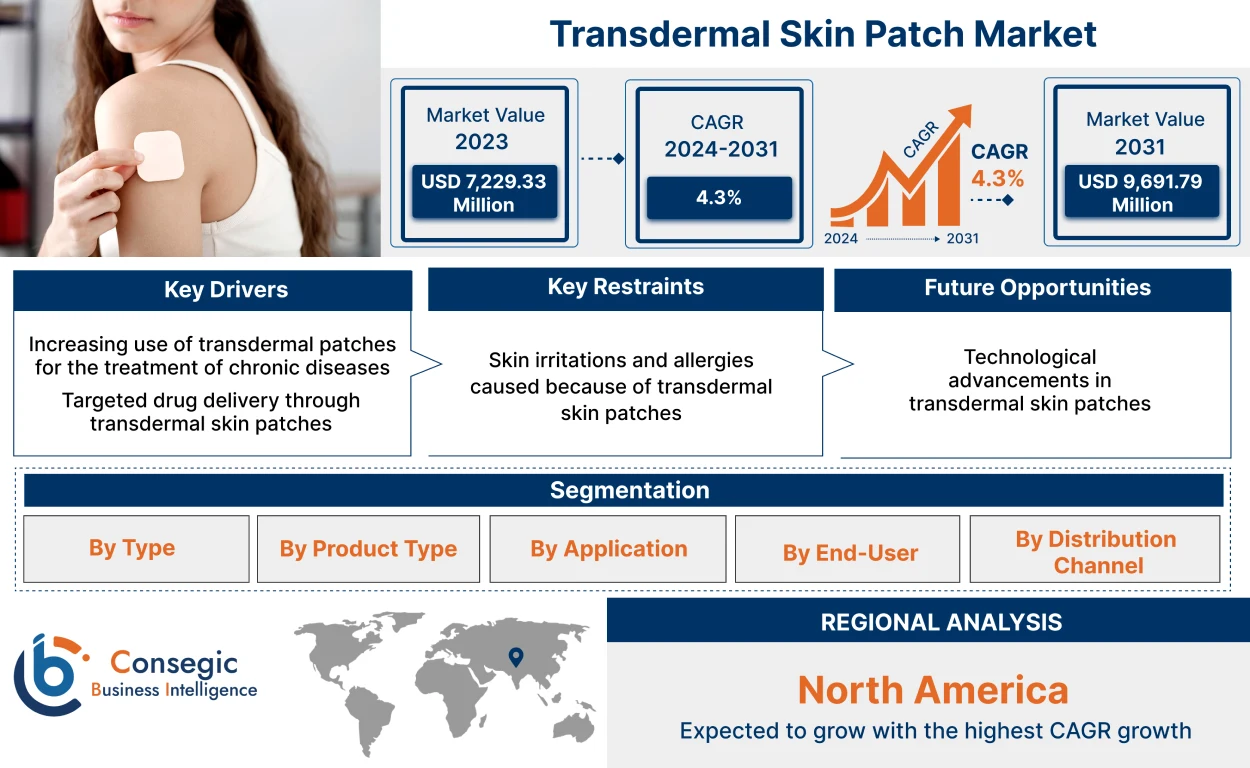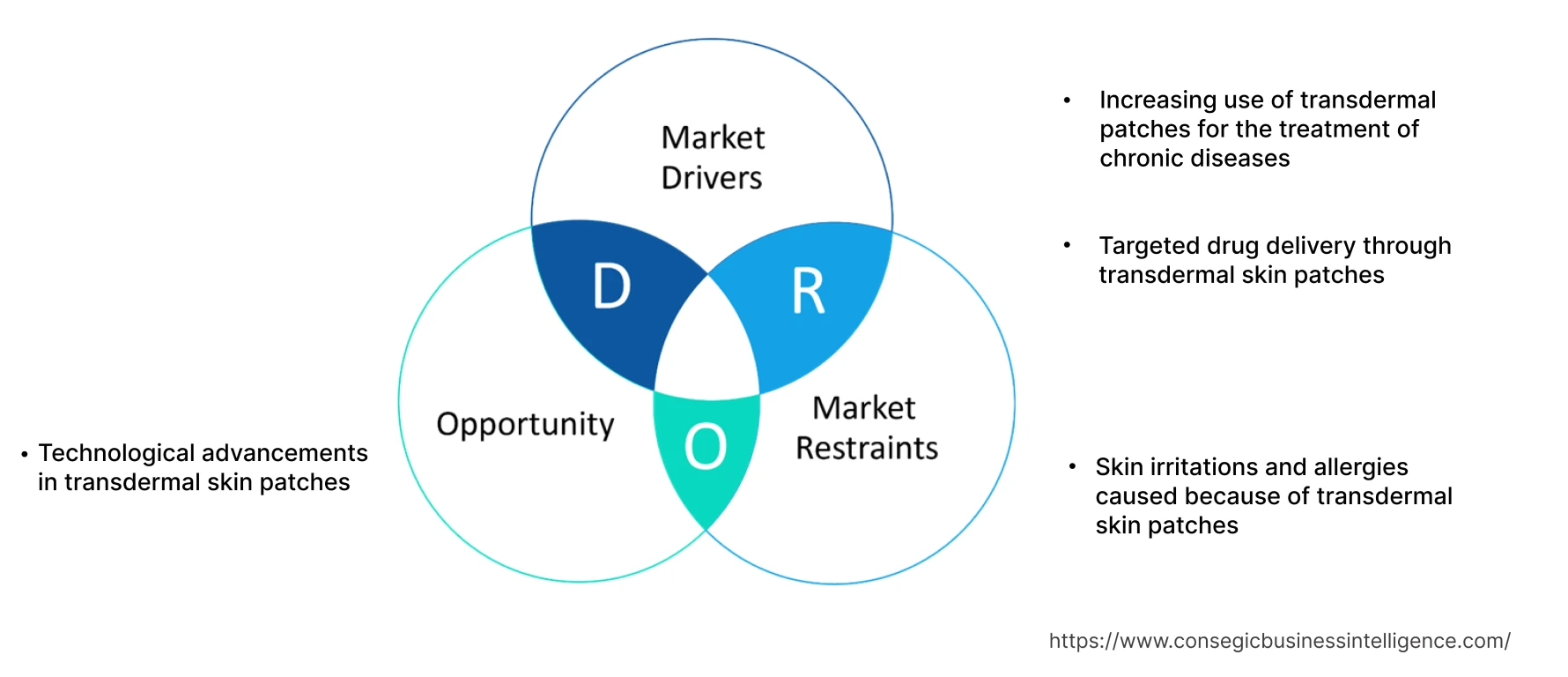- Summary
- Table Of Content
- Methodology
Transdermal Skin Patch Market Size :
Consegic Business Intelligence analyzes that the transdermal skin patch market size is growing with a CAGR 4.3% during the forecast period (2024-2031). The market accounted for USD 7,229.33 million in 2023, and the market is projected to be valued at USD 9,691.79 Million by 2031.
Transdermal Skin Patch Market Scope & Overview :
A transdermal skin patch is a medicated adhesive film, which is applied to the exterior of the skin. These patches contain medications and are used to apply a controlled dosage of medication through the skin and into the bloodstream. Transdermal patch have become an essential part of medicine delivery, especially for hormone replacement therapy, pain relief and to reduce smoking. The main advantage is the controlled, continuous release of medications, which increases patient compliance and reduces various side effects. As per the analysis, the continuous drug delivery and the non-invasive design of the patches improve the therapeutic result and the patient's commitment to treatment plans. This novel strategy tackles problems with conventional drug delivery techniques.
Transdermal patches are gaining popularity because of their convenience and improved patient experience. The controlled release of medication guarantees a consistent and predictable dosage which maximizes the efficiency efficiency of the therapeutic. In comparison to oral medications and injections, these patches are more patient-friendly because of their noninvasive application. Transdermal patches have the potential to completely change the way medications are administered, leading to a more efficient and patient-focused approach to healthcare, as confirmed by their increasing acceptance.
Transdermal Skin Patch Market Insights :
Key Drivers :
Increasing use of transdermal patches for the treatment of chronic diseases
Transdermal skin patches are growing as a significant drug delivery response to the widespread chronic disease. The rising prevalence of chronic illness worldwide is an issue that is impacted by aging populations, sedentary lifestyles, and dietary changes. Chronic diseases are long-term health problems that last for a considerable amount of time. These conditions often worsen over time and may need constant care. Diabetes, heart-related issues, respiratory issues, arthritis, and specific mental health issues are a few examples of chronic diseases.
These patches are considered a good therapeutic option because of their controlled and sustained drug release. The less invasive design of these patches and less intake of frequent medications are advantages of transdermal patches. Transdermal patches provide a regulated release of medicine, which allows a prolonged duration of therapeutic levels in the bloodstream. Based on the analysis, this lessens the side effects of drugs varying concentration and the constant concentration of drugs increases the efficiency. Patients with chronic illnesses may experience improved quality of life and better symptom management because of the steady release of medications into the bloodstream. Transdermal patches work by facilitating drug absorption through the skin by using specific formulations of medications for various chronic diseases.
For instance,
- In March 2022, FDA approved Xelstrym for the treatment of ADHD which is a chronic disease. Xelstrym is a skin patch launched by Noven Pharmaceuticals for adults and children above the age of 6.
Thus, the use of transdermal patches for the treatment of chronic diseases is boosting the expansion of the market.
Targeted drug delivery through transdermal skin patches
Transdermal skin patches with targeted drug delivery are an innovative pharmaceutical approach that allows for precise and controlled medication administration. Transdermal delivery enables medications to be administered directly to the skin, enabling absorption into the bloodstreamin contrast to conventional oral or systemic routes. Since the transdermal method allows for steady and regulated release of medications, as per the analysis, it is especially beneficial for accomplishing targeted drug delivery. For medication that needs precise dosages, calculations, or precise timing, controlled release is essential. Transdermal patches are made with formulations, that get past the skin's natural barrier and ensure effective drug absorption.
The capacity to sustain therapeutic drug levels in the bloodstream for a longer duration is one important advantage. In addition, to increase the efficiency of the treatment, the release of the medication is controlled which reduces the adverse effects of various drug concentrations. Transdermal patches are dependable treatment options for various diseases like hormone therapy, chronic pain management, and Alzheimer's disease.
For instance,
- In June 2023, the FDA approved a high dose of Exelon Patch 13.3 mg/24h for severe Alzheimers.
Thus, the use of transdermal patches for targeted treatment of various diseases is boosting the expansion of the market.
Key Restraints :
Skin irritations and allergies caused because of transdermal skin patches
Allergies and skin irritations present a significant obstacle to the widespread use of transdermal patches. Though they have many benefits such as controlled drug release and convenience, their trend has been hindered by the possibility of skin reactions. Transdermal patch's adhesive ingredients occasionally irritate the skin, which results in rashes, itching, and redness. Sensitive skin types may be vulnerable to these negative effects.
Additional factors contributing to these limitations are allergic reactions to patch material, such as adhesive or medication components. Based on the analysis, these allergies are caused because of glue and adhesive ingredients are known as contact dermatitis. These contact dermatitis usually cause irritation to the skin and are therefore known irritant contact dermatitis. For instance, the National Library of Medicine, in, reported that 80% of cases of dermatitis are of irritant dermatitis. It is usually caused because of factors such as allergies Thus, all these factors contribute to skin allergies which are hampering the transdermal skin patch market growth.
Future Opportunities :
Technological advancements in transdermal skin patches
The effectiveness, convenience, and safety of transdermal patches have been significantly enhanced by technological developments. The creation of microneedle patches, which are made of tiny needles that gently pierce the skin's outer layer to improve medication delivery without creating discomfort, is one significant invention. The production of nanoparticles for drug encapsulation has been made possible because of nanoformulation. As per the analysis, this encourages more regulated kinetics, which enhances therapeutic results while reducing adverse effects.
Another innovation is smart patches with sensors and microprocessors. These patches have the ability to track physiological variables, like blood sugar levels, and modify medications medication delivery. Materials that maximize drug permeation for better adsorption are experimented with to overcome various skin concerns.
For instance,
- The Massachusetts Institute of Technology, in April 2023, reported the development of a wearable patch that painlessly delivers drugs through the skin. The device uses ultrasonic waves to propel drug molecules and treat various skin conditions.
Thus, the above factors are creating lucrative transdermal skin patch market trends and opportunities for the development of the market.
Transdermal Skin Patch Market Report Insights :
| Report Attributes | Report Details |
| Study Timeline | 2018-2031 |
| Market Size in 2031 | USD 9,691.79 Million |
| CAGR (2024-2031) | 4.3% |
| By Type | Drug-In-Adhesive Transdermal Patch (Single-Layer Drug-In-Adhesive Transdermal Patch, Multi-Layer Drug-In-Adhesive Transdermal Patch), Reservoir Patch, Matrix Transdermal Patches, Microneedle Patch, and Others |
| By Product Type | Fentanyl Transdermal Skin Patch , Nicotine Transdermal Skin Patch, Clonidine Transdermal Skin Patch, Buprenorphine Transdermal Skin Patch, Oxybutynin Transdermal Skin Patch, and Others |
| By Application | Central Nervous System Disorders, Cardiovascular Disorders, Pain Management, Smoking Cessation, Hormonal Therapy, Dermatology, Overactive Bladder, and Others |
| By End User | Home Care settings, Hospitals, Clinics, and Others |
| By Distribution Channel | Online, and Offline (Hospital Pharmacies, Retail pharmacies) |
| By Region | North America, Europe, Asia Pacific, Latin America, and Middle East & Africa |
| Key Players | Teva Pharmaceutical Industries Ltd., Johnson & Johnson (Pty) Ltd, Sparsha Pharma International Pvt Ltd,ProSolus, Inc, ARx, LLC, Novartis Pharmaceuticals Corporation, Luye Pharma Group, Teikoku Seiyaku Co.,Ltd, Agile Therapeutics, Inc., Vektor Pharma, 3M, Nitto Denko Corporation |
| Geographies Covered | |
| North America | U.S. Canada Mexico |
| Europe | U.K. Germany France Spain Italy Russia Benelux Rest of Europe |
| APAC | China South Korea Japan India Australia ASEAN Rest of Asia-Pacific |
| Middle East and Africa | GCC Turkey South Africa Rest of MEA |
| LATAM | Brazil Argentina Chile Rest of LATAM |
| Report Coverage | Revenue Forecast, Competitive Landscape, Growth Factors, Restraint or Challenges, Opportunities, Environment & Regulatory Landscape, PESTLE Analysis, PORTER Analysis, Key Technology Landscape, Value Chain Analysis, Cost Analysis, and Regional Trends & Forecast |
Transdermal Skin Patch Market Segmental Analysis :
By Type :
The product type of segmentation is categorized into drug-in-adhesive transdermal patches, reservoir patches, matrix transdermal patches, microneedle patches, and others. The drug-in-adhesive transdermal patch is further bifurcated into single-layer drug-in-adhesive transdermal patch and multi-layer drug-in-adhesive transdermal patch. In 2023, the drug-in-adhesive transdermal patch segment accounted for the highest market share in the transdermal skin patch market. As per the analysis, ransdermal technology has advanced significantly with the development of drugs in adhesive patches. These patches have multiple benefits since they integrate the medication and the adhesive into one system. These in-adhesive patches integrate the therapeutic agent directly into the adhesive layer. This makes the patch simpler and easier to use by removing the need for extra layers of components. For instance, according to National Library of Medicine, in November 2022, reported in an article drug in adhesive transdermal patch containing antibiotic-loaded solid lipid nanoparticles that optimal transdermal patch formulation containing 90% adhesive solution, 7% cephalexin, and 3% cephalexin-loaded SLNs inhibited growth of S. aureus better than the formulation containing 90% adhesive solution and 10% cephalexin. In vitro evaluation of the growth of human fibroblast skin cells in media with the optimal patch exhibited greater proliferation (about 25.5%) than those in media without the patch. This shows that adhesive patches are simpler and easier to use. Thus, the above factors are creating lucrative trends for the development of the segment. As the medication is evenly distributed throughout the matrix, the release is regulated and sustained over time. The drug molecules progressively permeate into the skin and subsequently into the bloodstream because of the matrix.
For instance,
- In March 2020, according to the article published in Pharmaceutics Journal, the saturation solubility of lidocaine in different adhesive matrices was investigated to determine the maximum possible amount of drug that is solubilized in each matrix without the risk of it crystalizing upon removal of solvent and storage process. The saturation concentration of lidocaine in the adhesive was considered the highest concentration in which no particles or crystallization was observed.
Thus, the aforementioned factors are driving the growth of the segment.
By Product Type :
The product type of segmentation is categorized into fentanyl transdermal skin patch, nicotine transdermal skin patch, clonidine transdermal skin patch, buprenorphine transdermal skin patch, oxybutynin transdermal skin patch, and others. In 2023, nicotine transdermal skin patch segment accounted for the highest market transdermal skin patch market share. Transdermal nicotine patches, which provide a regulated and gradual release of nicotine through the skin into the blood system, are a type of smoking cessation aid. These patches assist smokers in quitting by reducing the cravings and withdrawal symptoms brought about by nicotine dependence. A range of patch concentrations are available, to progressively cut down on nicotine consumption. For instance, in August 2023, the World Health Organization reported the patches labeled by the average amount of nicotine released over 16 hours, a linear relationship exists between the released amount of nicotine (dose) and plasma levels of nicotine over the therapeutic dose range, 10-25mg/16 hours. Thus, these factors are boosting the growth of the segment.
Moreover, the fentanyl transdermal skin patch is expected to hold the highest CAGR over the forecast period. The powerful opioid analgesic fentanyl is applied topically as a transdermal skin patch to provide long-lasting pain relief for up to 72 hours. When applied topically, the drug is progressively released into the bloodstream, providing a useful treatment option for chronic pain, especially in cancer patients. However, accidental or excessive exposure to fentanyl patches by children and adults is recorded to be deadly. For instance, according to NCBI, in April 2023, reported that Fentanyl patches may cause serious or life-threatening breathing problems, especially during the first 24 to 72 hours of your treatment and any time your dose is increased. Thus, these Fentanyl patches should be used properly for better results against pain relief.
By Application :
The application segment is categorized into central nervous system disorders, cardiovascular disorders, pain management, smoking cessation, hormonal therapy, dermatology, overactive bladder, and others. In 2023, the pain management segment accounted for the highest market share of 29.04% in the transdermal skin patch market. Transdermal patches are a practical and efficient method of managing pain, particularly for long-term illnesses. The slow release lessens the need for frequent dosing by helping to maintain constant drug levels. Compared to oral medications, transdermal patches provide a non-invasive option with less high and low periods in drug concentrations, making them beneficial for people with chronic pain. These patches provide controlled and long-lasting pain relief by delivering drugs through the skin, such as opioids like fentanyl. For instance, according to the Journal of Forensic Science International: Reports, in December 2020, reported that transdermal patches of fentanyl are consumed by males more than females, males (68%) than females (32%). Thus, the use of transdermal patches for pain management is boosting the expansion of the market.
Moreover, smoking cessation is expected to hold the highest CAGR over the forecast period. Transdermal skin patches are a vital part of nicotine replacement therapy and are helpful in managing smoking cessation. By delivering precise amounts of nicotine through the skin these patches help people to quit smoking and have less craving and withdrawal symptoms. People gradually cut their nicotine intake with different strength patches, which help them to become nicotine-free. These patches offer a noninvasive way that encourages a more managed and long-term approach to smoking cessation. For instance, in November 2022, the Centers for Disease Control and Prevention stated that nicotine patches are approved by the FDA and are available to use in three strengths such as 7 mg, 14 mg, and 21 mg. Thus, these factors are boosting the expansion of the segment.
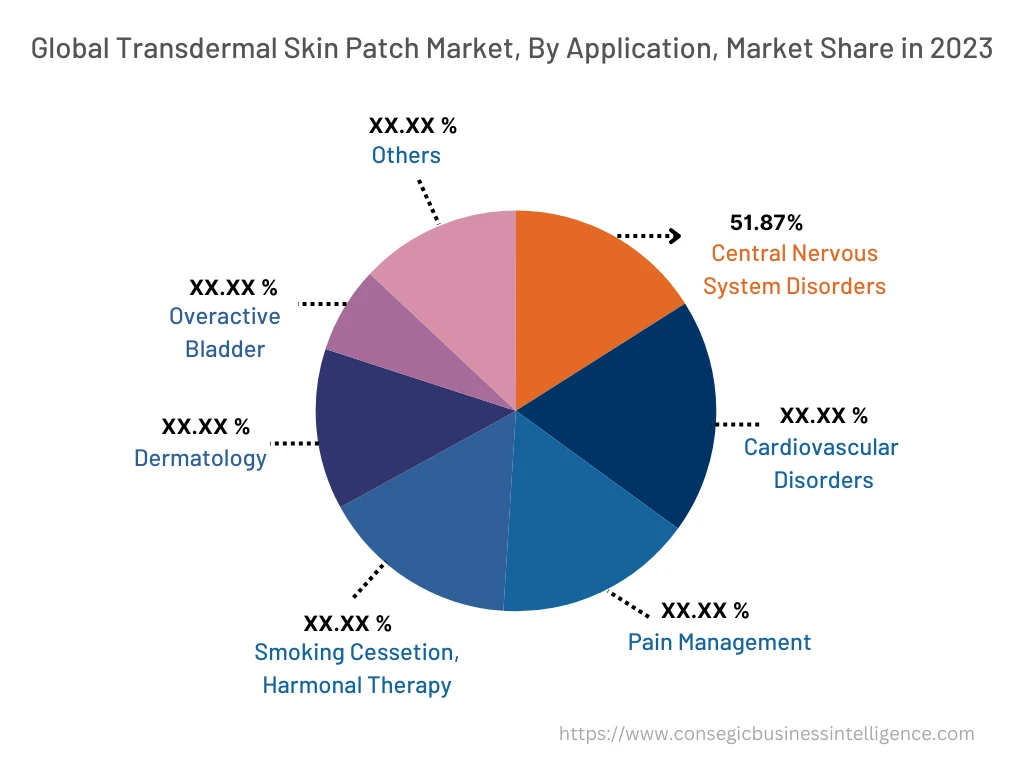
By End User :
The end user segment is categorized into hospitals, diagnostic centers, research institutes, and others. In 2023, the hospitals segment accounted for the highest market share of xx % in the end user segment, and are expected to hold the highest CAGR over the forecast period. Hospitals are the primary setting where chronic diseases are diagnosed and treated. Hospitals have the necessary infrastructure and resources to perform a variety of tests, including blood culture, nucleic acid testing (NAT), mass spectrometry, and many other tests for the detection and treatment of various chronic diseases. The increasing number of hospitals across the developing economies is driving the demand for chronic disease testing of the healthcare sector across the globe. For instance, according to the report by Investment Information and Credit Rating Agency, in August 2023, the hospital sector is expecting a robust revenue growth of 8-10% in FY24, with an operating profit margin of 22-23%. Thus, the growing demand for testing from the healthcare sector is driving the market trends.
By Distribution Channel :
The end user segment is categorized into online and offline. The offline segment is further bifurcated into hospital pharmacies, and retail pharmacies In 2023, the offline segment accounted for the highest market share of in the application segment and is expected to hold the highest CAGR over the forecast period. Transdermal skin patches are distributed through offline pharmacies, which provide a convenient and easily accessible route for those in need of this type of medication. In-person consultations with pharmacists are beneficial for patients as they offer proper guidance on appropriate usage, and potential side effects and address any concerns. In addition, they also ensure a steady supply of transdermal skin patches. For instance, in May 2023, Cabinet Health launched its National Pharmacies to expand access. Thus, these factors are boosting the trends of the segment.
By Region :
The regional segment includes North America, Europe, Asia Pacific, the Middle East and Africa, and Latin America.
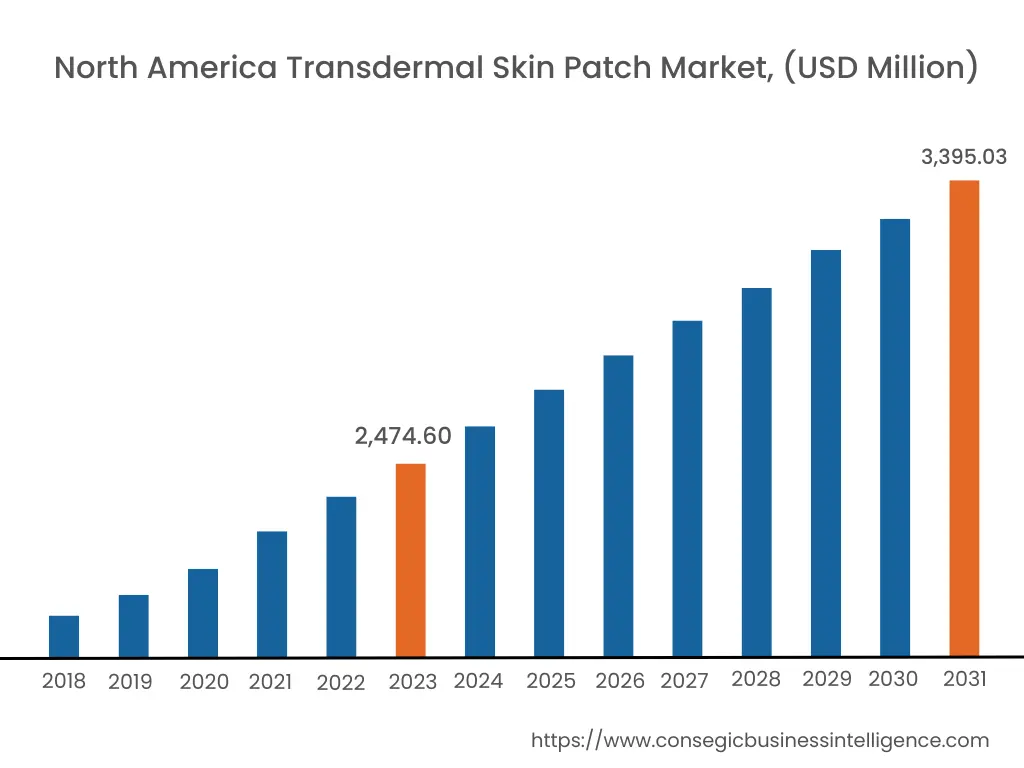
In 2023, North America accounted for the highest market share at 34.23% valued at USD 2,474.60 Million in 2023, it is expected to reach USD 3,395.03 Million in 2031. In North America, the U.S. accounted for the highest market share of 65.77% in the base year 2023. Based on the transdermal skin patch market analysis, the significant expansion in bloodstream infections across the North America region is driving the market expansion across the region. For instance, According to the Centers for Disease Control and Prevention (CDC) in September 2021, at least 1.7 million adults in the U.S. develop sepsis each year which leads to 270,000 every year. Furthermore, according to the report by the National Institute of Health in November 2022, An estimated 250,000 bloodstream infections occur annually, and most are related to the presence of intravascular devices. In the United States, the CLABSI rate in intensive care units (ICU) is estimated to be 0.8 per 1000 central line days. Thus, the growing prevalence of chronic disease in the North America region is driving the transdermal skin patch market demand and trends.
Furthermore, the Asia Pacific region is expected to witness significant growth over the forecast period, growing at a CAGR of 5.1% during 2023-2031. The significant growth in healthcare infrastructure across the region across the region is increasing demand for transdermal skin patches. For instance, according to a report by the National Institute of Health in May 2023, China's healthcare budget is gradually increasing. The ratio of health expenditures to GDP in 2021 was 6.5%. It was only 4.3% to 5.2% during the period from 2000 to 2010. The total national health expenditure in 2021 will be USD 1,184.9 billion. Thus, the significant growth in healthcare infrastructure is expected to create lucrative trends and transdermal skin patch market opportunities over the forecast period.
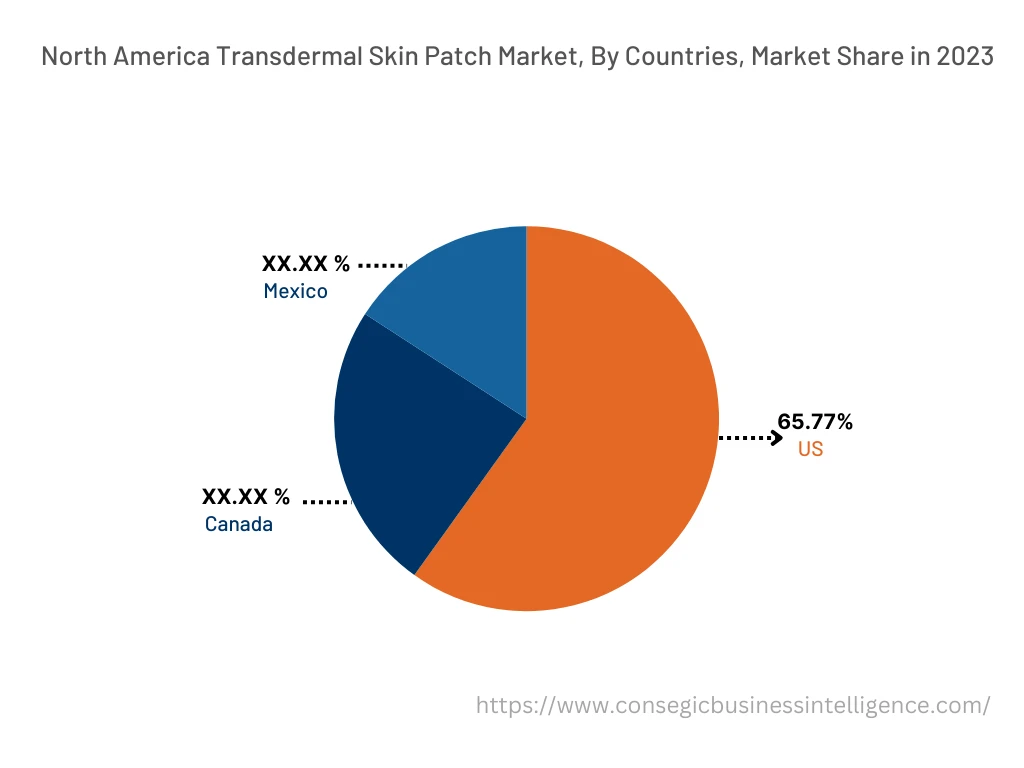
Top Key Players & Market Share Insights :
The global transdermal skin patch market is highly competitive, with several large players and numerous small and medium-sized enterprises. These companies have strong research and development capabilities and a strong presence in the market through their extensive product portfolios and distribution networks. The transdermal skin patch industry is characterized by intense competition, with companies focusing on expanding their product offerings and increasing their market through mergers, acquisitions, and partnerships. The key players in the market include-
The key players in the market include-
Recent Industry Developments :
- In January 2024, Starton Therapeutics announces the Launch of STARSILON a novel transdermal patch delivery platform.
Key Questions Answered in the Report
What was the market size of the Transdermal Skin Patch Market in 2023? +
In 2023, the market size of transdermal skin patches was USD 7,229.33 million.
What will be the potential market valuation for the transdermal skin patches by 2031? +
In 2031, the market size of transdermal skin patches will be expected to reach USD 9,691.79 million.
What are the key factors driving the growth of the Transdermal Skin Patch Market? +
Increasing incidences of chronic diseases across the globe are fueling market growth at the global level.
What is the dominant segment in the Transdermal Skin Patch Market for the application? +
In 2023, the pain management segment accounted for the highest market share of 29.04% in the overall Transdermal Skin Patch Market.
Based on current market trends and future predictions, which geographical region is the dominating region in the transdermal skin patchesmarket? +
North America accounted for the highest market share in the overall market.
